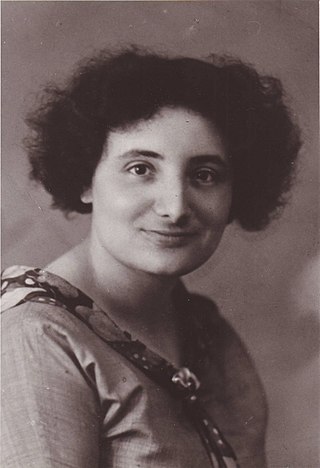
Hildegard Brom-Fischer (1908-2001) was a Dutch textile artist, specializing in ecclesiastical embroidery.

Hildegard Brom-Fischer (1908-2001) was a Dutch textile artist, specializing in ecclesiastical embroidery.
Brom-Fischer was born on 16 July 1908 in Coesfeld, Germany. [1] [2] She studied at the training center for applied arts Werkkunstschule in Münster, Germany. [3] She studied with Joos Jaspert. [4] By 1937 she had located to the Netherlands, living in Amsterdam, Oudenrijn, Utrecht, and Bunnik. Brom-Fischer was a member of Nederlandsche Vereeniging voor Ambachts- en Nijverheidskunst (V.A.N.K.) the Dutch Association for Craft and Craft Art. [5] She was married to Jan Eloy Brom. [3] Focusing on Christian themes, she created multiple pieces featuring Saints Cosmas and Damian. [6]
Brom-Fischer exhibited at the 1933 Milan Triennial and the Stedelijk Museum Amsterdam. [4]
Brom-Fischer died on 22 April 2001 in Utrecht. [2] Her work is in the collection of the Museum Catharijneconvent in Utrecht. [7]

Utrecht is the fourth-largest city and a municipality of the Netherlands, capital and most populous city of the province of Utrecht. It is located in the eastern corner of the Randstad conurbation, in the very centre of mainland Netherlands. It has a population of 361,699 as of December 2021.

Geert Paul Hendrikus Schuitema was a Dutch graphic artist. He also designed furniture and expositions and worked as photographer, film director, painter and teacher for publicity design at the Royal Academy of Art in The Hague.

Emmy Eugenie Andriesse was a Dutch photographer best known for her work with the Underground Camera group during World War II.

Christiaan "Chris" Johannes van der Hoef was a Dutch sculptor. He was born in Amsterdam and died in The Hague. In 1928 he won a silver medal in the art competitions of the Olympic Games for his "Médaille pour les Jeux Olympiques". Van der Hoef was a member of Nederlandsche Vereeniging voor Ambachts- en Nijverheidskunst (V.A.N.K.) the Dutch Association for Craft and Craft Art.

Jonkheer Willem Jacob Henri Berend Sandberg known as Willem Sandberg was a Dutch typographer, museum curator, and member of the Dutch resistance during World War II.

Aart van Dobbenburgh was a Dutch graphic artist known for his fine lithographs. Popular themes in his work included flowers, portraits, and landscapes, but human hands were his favorite. Dobbenburgh illustrated among others the books of the Russian writers Leo Tolstoy and Fyodor Dostoyevsky.

Charles Breijer was a Dutch photographer, known as a "resistance photographer," notable especially for the photographs he took during the last year of the German occupation of The Netherlands during World War II. Breijer was a member of Nederlandsche Vereeniging voor Ambachts- en Nijverheidskunst (V.A.N.K.) the Dutch Association for Craft and Craft Art.

Éva Besnyő (1910–2003) was a Dutch-Hungarian photographer who participated in the Nieuwe Fotografie movement.

Frederika Sophia "Fré" Cohen was a Dutch artist and graphic designer.

Peter Alma was a Dutch artist. Alma was born in Medan, Indonesia and attended the Royal Academy of Art, The Hague in 1904. On the recommendation of Franz Seiwert he was employed by the Gesellschafts- und Wirtschaftsmuseum working with Gerd Arntz and Augustin Tschinkel on the development of Isotypes. He travelled to Moscow with Arntz and Otto Neurath to work at IZOSTAT to help them draw up pictorial images for statistics of the Five Year Plans. Alma was a member of Nederlandsche Vereeniging voor Ambachts- en Nijverheidskunst (V.A.N.K.) the Dutch Association for craft and craft art. He painted a number of large murals in and around Amsterdam in the 1930s.

Theodorus Henricus Antonius Adolph Molkenboer was a Dutch painter and designer, notably, of book covers and posters. He was also an expert on the history of Dutch folk costumes and wrote several short works on that subject.

Johanna Gerarda Theodora van Eybergen was a Dutch artist specializing in applied arts and design, notable for her Art Nouveau work on metal. She was the first and for a long time the only Duch woman artist working on design on metal.

Casparus Bernardus Oorthuys, known as Cas Oorthuys, was a Dutch photographer and designer active from the 1930s until the 1970s.

Karel Petrus Cornelis de Bazel was a modern Dutch architect, engraver, draftsman, furniture designer, carpet designer, glass artist and bookbinding designer. He was the teacher of Adriaan Frederik van der Weij and the first chairman of the Bond van Nederlandse Architecten, beginning in 1909.

Catharine Louise "Kitty" van der Mijll Dekker (1908-2004) was a Dutch textile artist. She studied at the Bauhaus and her designs are still being produced.

Anna Sipkema (1877–1933) was a Dutch graphic designer and textile artist. She is known mainly today for her book covers and calendars.

Wilhelmina "Willie" Cornelia Drupsteen (1880–1966) was a Dutch illustrator. She is known for her graphic work and book illustrations.

The Nederlandsche Vereeniging voor Ambachts- en Nijverheidskunst (V.A.N.K.) was founded in 1904. It was founded by Jacob Pieter van den Bosch, Herman Hana, Klaas van Leeuwen, Theo Molkenboer, and Willem Penaat. At the turn of the century the idea of artist-craftsmen was emerging. The existing Dutch societies and clubs for painters and architects did not adequately represent these artisans and they formed V.A.N.K., the first society for designers in the Netherlands.

Sophie Verrijn Stuart (1890–1946) was a Dutch ceramicist.

Johanna Berhardina Midderigh-Bokhorst (1880–1972) was a Dutch illustrator.